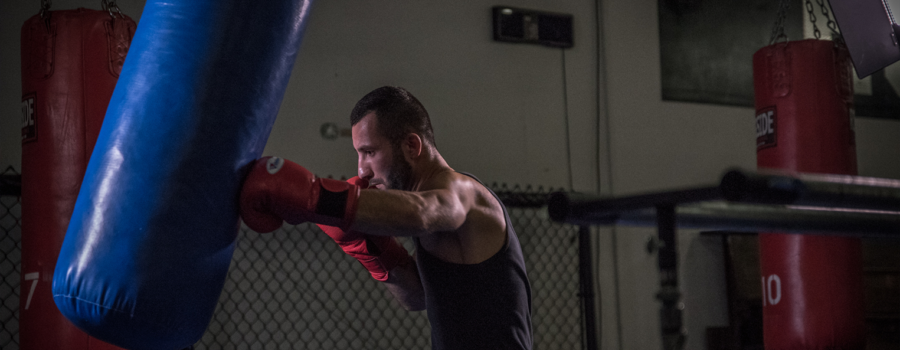This article is a guest post by Maral Papazian at nazoboxing.com. For some of the best gear out there, please be sure to check out Nazo Boxing.
Boxing is one of the most loved combat sports. Millions of people train for boxing to get fit and become stronger.
If you’re looking to train at home, you need a good-quality punching bag to start with. In this quick guide, we cover the most important things to look for when choosing a punching bag.

1. Quality
When buying any equipment or tool for sports, the first thing you should look at is the craftsmanship. While it’s true that quality punching bags cost more, they are built to sustain wear and tear.
A good-quality punching bag is made of well-thought materials. A thorough inspection should help you assess whether it’s sturdy enough to last for years.
Things like double-stitched seams, single-ended design, and heavy-duty straps or chains are some of the things that indicate a reliable punching bag.
Additionally, all areas of the bag should remain consistent. Meaning, there shouldn’t be any area that is softer or harder than the rest.
2. Size
You should also look for the correct punching bag size for your training needs.
Very light punching bags can be annoying because they swing badly every time you hit the bag. On the other hand, an extremely heavy bag will drain your energy with just a few blows.
When looking for a punching bag, consider your age and size.
The general rule for an adult heavy bag is it should be approximately half your weight. This means if you weigh 200 pounds, you should pick a 100-pound bag.
In terms of length, choose a bag that’s about four or five feet. Such a height is ideal for punches, hooks, knees, and even kicks.
Lastly, to build strength and power, you also need a punching bag with a thick diameter.
3. Shape
Shape matters too… a lot. Punching bags come in varying shapes, but the standard is cylindrical. It’s a great all-around bag that works for both beginners and advanced levels.
If you’re working on improving your striking styles, you may also benefit from specialized punching bags that come in different shapes, such as:
● Angled Punching Bag
This bag has a wider top than the bottom, which is great for practicing realistic uppercuts, short rights, and left hooks.

● Teardrop Heavy Bag
This bag is also angled but has a more subtle difference in the width of the top and bottom parts. A teardrop bag is much lighter since it’s meant to synthesize an opponent’s movement (fighters don’t stand still in a real boxing match). This bag is best used for practicing footwork, timing, and speed.

● Speed Bag
This small, round ball swings back and forth with every punch. It’s great for working out your punching rhythm, hand-eye coordination, timing, and speed.

There are many other types of punching bags used for boxing aside from these we mentioned.
However, if you’re just starting, we recommend high-quality boxing punching bags that have the standard cylindrical shape. You can add more heavy bags to your home gym as you progress with your training.
4. Outer Cover
A good punching bag is something you can use for a long time. That said, you want to invest in a bag that is made of sturdy materials.
Currently, the best punching bags for boxing are those made from high-quality leather. Leather can be very expensive, but you will be rewarded with a durable and comfortable punching bag. If you can afford it, go for it.
Some heavy bags are made of synthetic leather which is also a good option. It’s a bit cheaper than the real one but it certainly gets the job done.
5. Bag Fill Material
Another consideration when choosing a punching bag is the fill material. Essentially, it determines the weight, comfort, and firmness of a punching bag.
There are different types of fill materials used in punching bags. These two are among the most common:
● Sand
This is the most recommended option for boxers who want their punching bags to be substantially heavy. If choosing a sandbag, it’s best to look for one that’s covered in high-quality leather because sand tends to change in hardness if exposed to moisture.
● Textile
Punching bags made of textile fillings are comfortable. They’re an excellent pick for people who want to reduce muscle strain on their shoulders, elbows, and wrist. Some heavy bags have a foam layer which helps absorb impact better.
6. Support
A punching bag can either come with a wall-mounted bracket or a free-standing support frame.
Conventional bags make use of a wall-mounted bracket, thus, they are extremely sturdy and secured. However, you may choose a bag with a free-standing support frame if you can’t or don’t want to use a wall-mounted bracket.
Do note, however, that the strength of this punching bag is limited and its structure won’t allow free movement around the entire bag.
Conclusion
Choosing a good punching bag is not a difficult task as long as you know what to look for. Always consider the quality and build, size, shape, materials, and support to find the perfect heavy bag for your training needs.
This article is a guest post by Maral Papazian at nazoboxing.com. For some of the best gear out there, please be sure to check out Nazo Boxing.


Recent Comments